Grant P. Strimel
SIFT-50M: A Large-Scale Multilingual Dataset for Speech Instruction Fine-Tuning
Apr 12, 2025Abstract:We introduce SIFT (Speech Instruction Fine-Tuning), a 50M-example dataset designed for instruction fine-tuning and pre-training of speech-text large language models (LLMs). SIFT-50M is built from publicly available speech corpora, which collectively contain 14K hours of speech, and leverages LLMs along with off-the-shelf expert models. The dataset spans five languages, encompassing a diverse range of speech understanding as well as controllable speech generation instructions. Using SIFT-50M, we train SIFT-LLM, which outperforms existing speech-text LLMs on instruction-following benchmarks while achieving competitive performance on foundational speech tasks. To support further research, we also introduce EvalSIFT, a benchmark dataset specifically designed to evaluate the instruction-following capabilities of speech-text LLMs.
Search Optimization with Query Likelihood Boosting and Two-Level Approximate Search for Edge Devices
Dec 12, 2023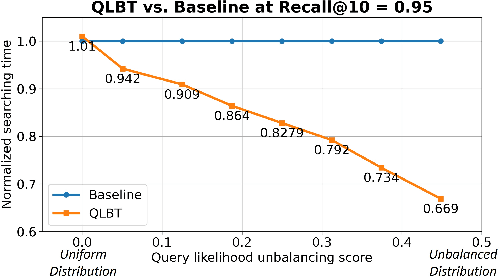

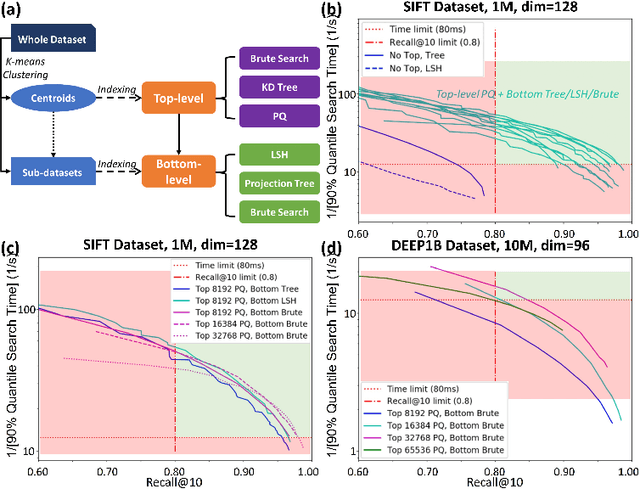
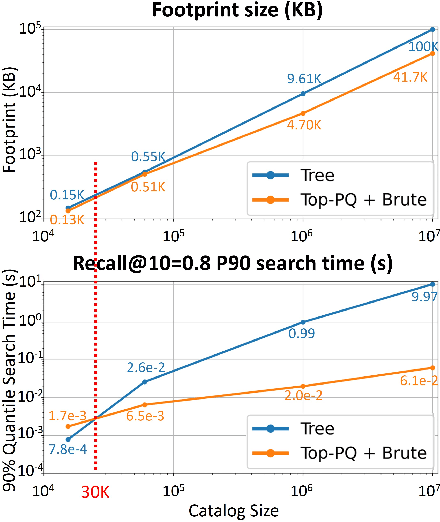
Abstract:We present a novel search optimization solution for approximate nearest neighbor (ANN) search on resource-constrained edge devices. Traditional ANN approaches fall short in meeting the specific demands of real-world scenarios, e.g., skewed query likelihood distribution and search on large-scale indices with a low latency and small footprint. To address these limitations, we introduce two key components: a Query Likelihood Boosted Tree (QLBT) to optimize average search latency for frequently used small datasets, and a two-level approximate search algorithm to enable efficient retrieval with large datasets on edge devices. We perform thorough evaluation on simulated and real data and demonstrate QLBT can significantly reduce latency by 15% on real data and our two-level search algorithm successfully achieve deployable accuracy and latency on a 10 million dataset for edge devices. In addition, we provide a comprehensive protocol for configuring and optimizing on-device search algorithm through extensive empirical studies.
Accelerator-Aware Training for Transducer-Based Speech Recognition
May 12, 2023



Abstract:Machine learning model weights and activations are represented in full-precision during training. This leads to performance degradation in runtime when deployed on neural network accelerator (NNA) chips, which leverage highly parallelized fixed-point arithmetic to improve runtime memory and latency. In this work, we replicate the NNA operators during the training phase, accounting for the degradation due to low-precision inference on the NNA in back-propagation. Our proposed method efficiently emulates NNA operations, thus foregoing the need to transfer quantization error-prone data to the Central Processing Unit (CPU), ultimately reducing the user perceived latency (UPL). We apply our approach to Recurrent Neural Network-Transducer (RNN-T), an attractive architecture for on-device streaming speech recognition tasks. We train and evaluate models on 270K hours of English data and show a 5-7% improvement in engine latency while saving up to 10% relative degradation in WER.
* Accepted to SLT 2022
Robust Acoustic and Semantic Contextual Biasing in Neural Transducers for Speech Recognition
May 09, 2023Abstract:Attention-based contextual biasing approaches have shown significant improvements in the recognition of generic and/or personal rare-words in End-to-End Automatic Speech Recognition (E2E ASR) systems like neural transducers. These approaches employ cross-attention to bias the model towards specific contextual entities injected as bias-phrases to the model. Prior approaches typically relied on subword encoders for encoding the bias phrases. However, subword tokenizations are coarse and fail to capture granular pronunciation information which is crucial for biasing based on acoustic similarity. In this work, we propose to use lightweight character representations to encode fine-grained pronunciation features to improve contextual biasing guided by acoustic similarity between the audio and the contextual entities (termed acoustic biasing). We further integrate pretrained neural language model (NLM) based encoders to encode the utterance's semantic context along with contextual entities to perform biasing informed by the utterance's semantic context (termed semantic biasing). Experiments using a Conformer Transducer model on the Librispeech dataset show a 4.62% - 9.26% relative WER improvement on different biasing list sizes over the baseline contextual model when incorporating our proposed acoustic and semantic biasing approach. On a large-scale in-house dataset, we observe 7.91% relative WER improvement compared to our baseline model. On tail utterances, the improvements are even more pronounced with 36.80% and 23.40% relative WER improvements on Librispeech rare words and an in-house testset respectively.
Lookahead When It Matters: Adaptive Non-causal Transformers for Streaming Neural Transducers
May 09, 2023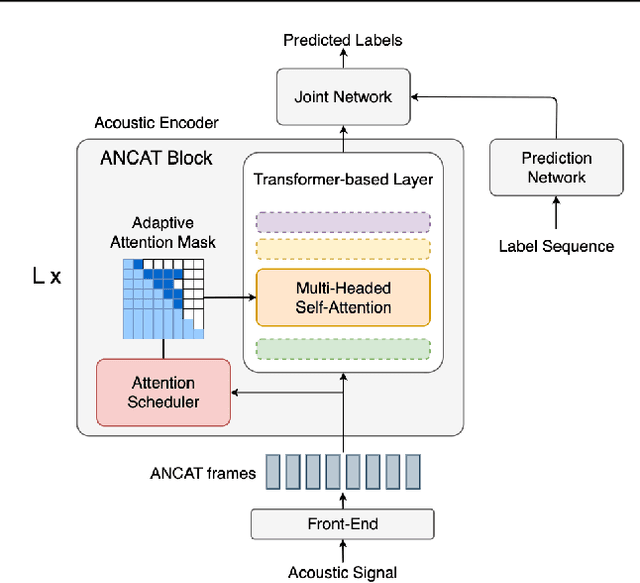
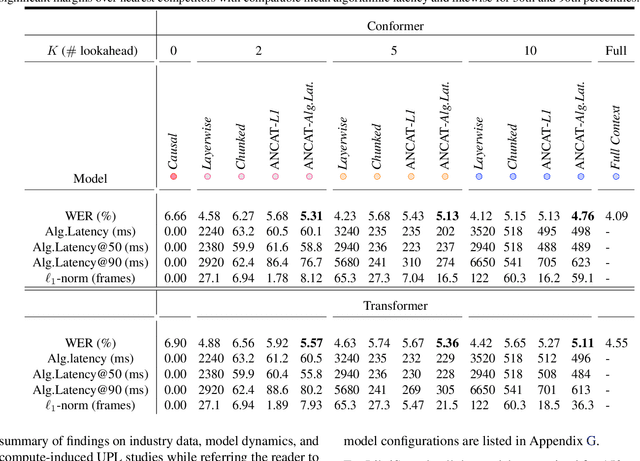
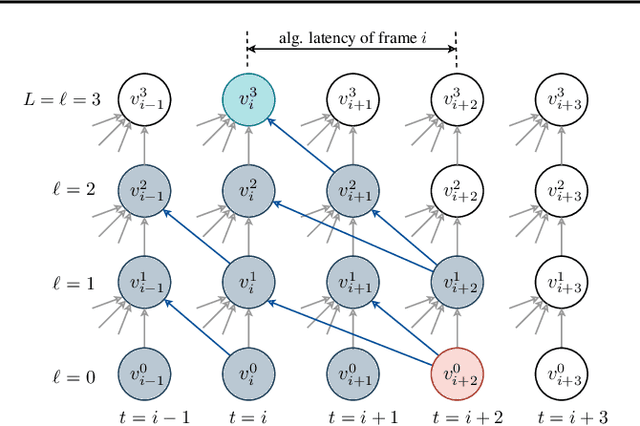
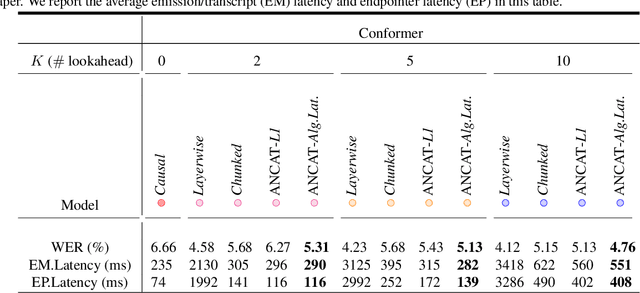
Abstract:Streaming speech recognition architectures are employed for low-latency, real-time applications. Such architectures are often characterized by their causality. Causal architectures emit tokens at each frame, relying only on current and past signal, while non-causal models are exposed to a window of future frames at each step to increase predictive accuracy. This dichotomy amounts to a trade-off for real-time Automatic Speech Recognition (ASR) system design: profit from the low-latency benefit of strictly-causal architectures while accepting predictive performance limitations, or realize the modeling benefits of future-context models accompanied by their higher latency penalty. In this work, we relax the constraints of this choice and present the Adaptive Non-Causal Attention Transducer (ANCAT). Our architecture is non-causal in the traditional sense, but executes in a low-latency, streaming manner by dynamically choosing when to rely on future context and to what degree within the audio stream. The resulting mechanism, when coupled with our novel regularization algorithms, delivers comparable accuracy to non-causal configurations while improving significantly upon latency, closing the gap with their causal counterparts. We showcase our design experimentally by reporting comparative ASR task results with measures of accuracy and latency on both publicly accessible and production-scale, voice-assistant datasets.
Dual-Attention Neural Transducers for Efficient Wake Word Spotting in Speech Recognition
Apr 05, 2023



Abstract:We present dual-attention neural biasing, an architecture designed to boost Wake Words (WW) recognition and improve inference time latency on speech recognition tasks. This architecture enables a dynamic switch for its runtime compute paths by exploiting WW spotting to select which branch of its attention networks to execute for an input audio frame. With this approach, we effectively improve WW spotting accuracy while saving runtime compute cost as defined by floating point operations (FLOPs). Using an in-house de-identified dataset, we demonstrate that the proposed dual-attention network can reduce the compute cost by $90\%$ for WW audio frames, with only $1\%$ increase in the number of parameters. This architecture improves WW F1 score by $16\%$ relative and improves generic rare word error rate by $3\%$ relative compared to the baselines.
Dialog act guided contextual adapter for personalized speech recognition
Mar 31, 2023
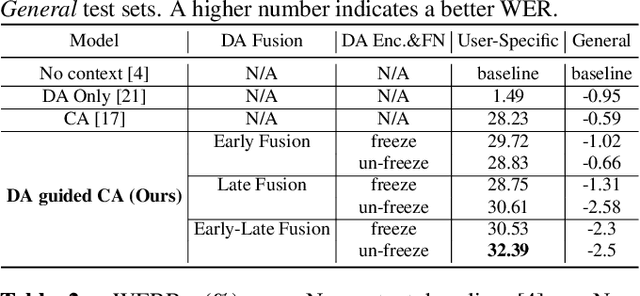
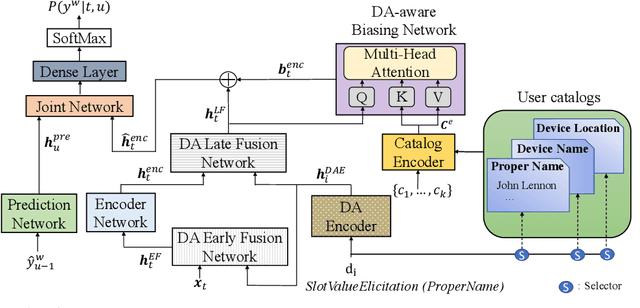
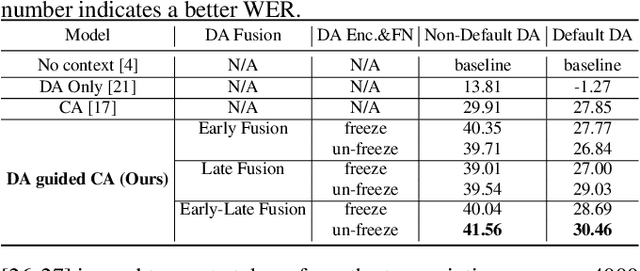
Abstract:Personalization in multi-turn dialogs has been a long standing challenge for end-to-end automatic speech recognition (E2E ASR) models. Recent work on contextual adapters has tackled rare word recognition using user catalogs. This adaptation, however, does not incorporate an important cue, the dialog act, which is available in a multi-turn dialog scenario. In this work, we propose a dialog act guided contextual adapter network. Specifically, it leverages dialog acts to select the most relevant user catalogs and creates queries based on both -- the audio as well as the semantic relationship between the carrier phrase and user catalogs to better guide the contextual biasing. On industrial voice assistant datasets, our model outperforms both the baselines - dialog act encoder-only model, and the contextual adaptation, leading to the most improvement over the no-context model: 58% average relative word error rate reduction (WERR) in the multi-turn dialog scenario, in comparison to the prior-art contextual adapter, which has achieved 39% WERR over the no-context model.
Sub-8-bit quantization for on-device speech recognition: a regularization-free approach
Oct 17, 2022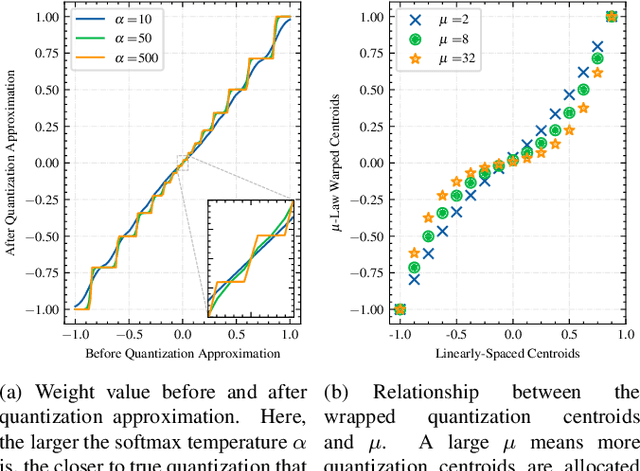
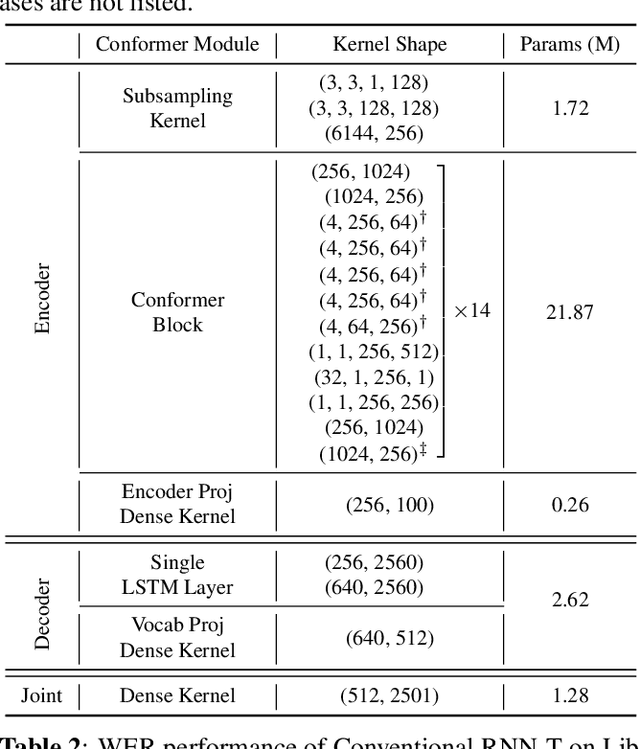

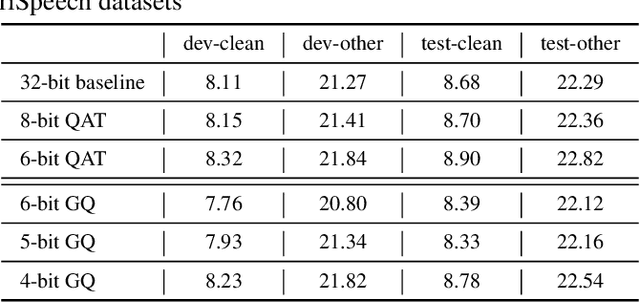
Abstract:For on-device automatic speech recognition (ASR), quantization aware training (QAT) is ubiquitous to achieve the trade-off between model predictive performance and efficiency. Among existing QAT methods, one major drawback is that the quantization centroids have to be predetermined and fixed. To overcome this limitation, we introduce a regularization-free, "soft-to-hard" compression mechanism with self-adjustable centroids in a mu-Law constrained space, resulting in a simpler yet more versatile quantization scheme, called General Quantizer (GQ). We apply GQ to ASR tasks using Recurrent Neural Network Transducer (RNN-T) and Conformer architectures on both LibriSpeech and de-identified far-field datasets. Without accuracy degradation, GQ can compress both RNN-T and Conformer into sub-8-bit, and for some RNN-T layers, to 1-bit for fast and accurate inference. We observe a 30.73% memory footprint saving and 31.75% user-perceived latency reduction compared to 8-bit QAT via physical device benchmarking.
ConvRNN-T: Convolutional Augmented Recurrent Neural Network Transducers for Streaming Speech Recognition
Sep 29, 2022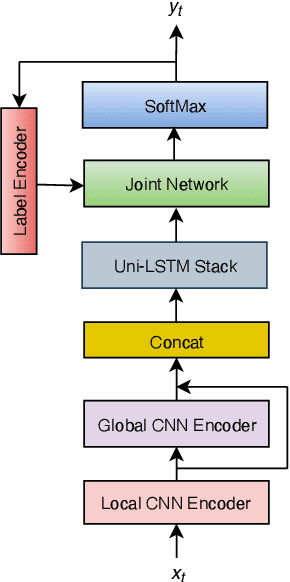
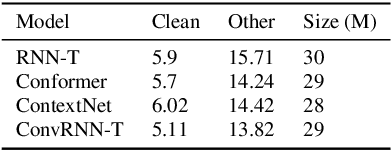
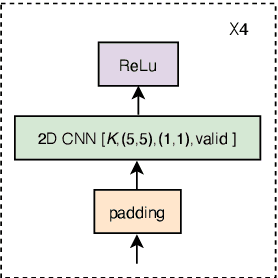
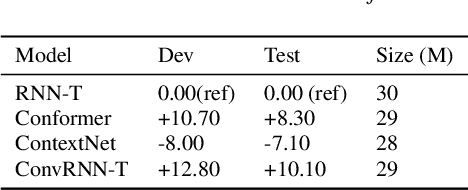
Abstract:The recurrent neural network transducer (RNN-T) is a prominent streaming end-to-end (E2E) ASR technology. In RNN-T, the acoustic encoder commonly consists of stacks of LSTMs. Very recently, as an alternative to LSTM layers, the Conformer architecture was introduced where the encoder of RNN-T is replaced with a modified Transformer encoder composed of convolutional layers at the frontend and between attention layers. In this paper, we introduce a new streaming ASR model, Convolutional Augmented Recurrent Neural Network Transducers (ConvRNN-T) in which we augment the LSTM-based RNN-T with a novel convolutional frontend consisting of local and global context CNN encoders. ConvRNN-T takes advantage of causal 1-D convolutional layers, squeeze-and-excitation, dilation, and residual blocks to provide both global and local audio context representation to LSTM layers. We show ConvRNN-T outperforms RNN-T, Conformer, and ContextNet on Librispeech and in-house data. In addition, ConvRNN-T offers less computational complexity compared to Conformer. ConvRNN-T's superior accuracy along with its low footprint make it a promising candidate for on-device streaming ASR technologies.
Compute Cost Amortized Transformer for Streaming ASR
Jul 05, 2022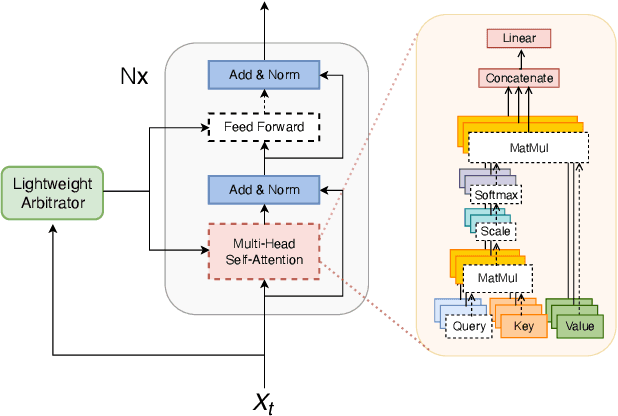
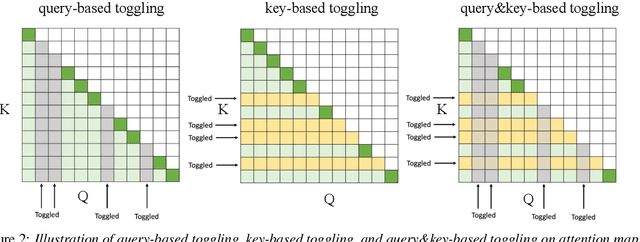
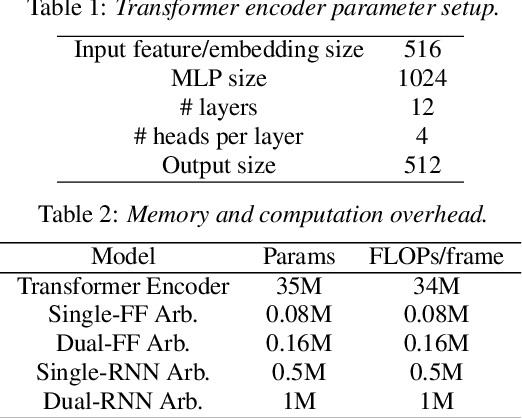
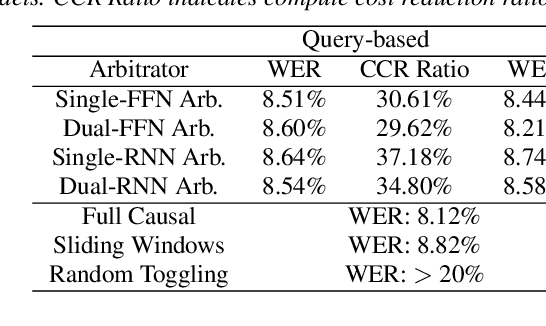
Abstract:We present a streaming, Transformer-based end-to-end automatic speech recognition (ASR) architecture which achieves efficient neural inference through compute cost amortization. Our architecture creates sparse computation pathways dynamically at inference time, resulting in selective use of compute resources throughout decoding, enabling significant reductions in compute with minimal impact on accuracy. The fully differentiable architecture is trained end-to-end with an accompanying lightweight arbitrator mechanism operating at the frame-level to make dynamic decisions on each input while a tunable loss function is used to regularize the overall level of compute against predictive performance. We report empirical results from experiments using the compute amortized Transformer-Transducer (T-T) model conducted on LibriSpeech data. Our best model can achieve a 60% compute cost reduction with only a 3% relative word error rate (WER) increase.
 Add to Chrome
Add to Chrome Add to Firefox
Add to Firefox Add to Edge
Add to Edge